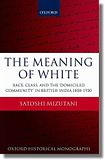The Meaning of White
Mizutani, Satoshi:
The Meaning of White : race, class, and the 'domiciled community' in British India 1858 - 1930 / Satoshi Mizutani. - Oxford [u.a.] : Oxford Univ. Press, 2011. - X, 239 S. - (Oxford historical monographs)
Hochschulschrift. Teilw. zugl.: Oxford, Univ., Diss., 2004 unter dem Titel: The British in India and their domiciled brethren : race and class in the colonial context, 1858-1930
ISBN 978-0-19-969770-0
£ 60,00 / US$ 110,00
DOI: 10.1093/acprof:oso/9780199697700.001.0001
DDC: 305.809054
Beschreibung
From 1858 to 1930 the concept of whiteness in British India was complex and contradictory. Under the Raj, the spread of racial ideologies was pervasive, but whiteness was never taken as self-evident. It was constantly called into question and its boundaries were disciplined and policed through socio-cultural and institutional practices.
Only those whites with social status, cultural refinement, and the right level of education were able to command the respect and awe of colonized subjects. Among those who straddled the boundaries of whiteness were the 'domiciled community', made up of mixed-descent 'Eurasians' and racially unmixed 'Domiciled Europeans', both of whom lived in India on a permanent basis. Members of this community, or those who were categorized as such under the Raj, unwittingly rendered the meaning of whiteness ambiguous in fundamental ways.
The colonial authorities quickly identified the domiciled community as a particularly malign source of political instability and social disorder, and were constantly urged to furnish various institutional measures - predominantly philanthropic and educational by character - that specifically targeted its degraded conditions. The Meaning of White reveals the precise ways in which the existence of this community was identified as a problem (the 'Eurasian Question') and examines the deeper historical meanings of this categorization. Dr Mizutani demystifies the ideology of whiteness, situating it within the concrete social realities of colonial history. [Verlagsinformation]
Inhalt
List of Maps and Illustrations. xi
Abbreviations. xii
Introduction: India's "Domiciled Community": The Ambivalence of Whiteness under the British Raj. 1
1. British prestige and fears of colonial degeneration. 14
2. The origins and emergence of the "domiciled community". 48
3. The "Eurasian Question": the domiciled poor and urban social control. 78
4. "European schools": illiteracy, unemployment, and educational uplifting. 116
5. Towards a solution to the Eurasian Question: child removal and juvenile emigration. 137
6. Disputing the domiciliary divide: civil-service employment and the claim for equivalence. 181
7. Conclusion: Race, class, and the contours of whiteness in late British India. 219
Select Bibliography. 224
Index. 235
Autor
SATOSHI MIZUTANI (水谷智) was educated at Sophia University (Japan), the University of Warwick, and St. Antony's College, Oxford before obtaining a DPhil from the History Faculty at Oxford. Associate Professor, Institute for Language and Culture, Doshisha University. Profile page (japan.), profile page (engl.).
Quellen: Oxford University Press (USA); Oxford University Press (UK); WorldCat; Google Books; Amazon (UK)
Ähnlich
- Writing India
- Mixed-Race and Modernity in Colonial India
- Viswanath: The Pariah Problem
- Sohi: Echoes of Mutiny
- Migration and Religion in Europe
- Swank: Rewriting Shangri-La
- The Jews of Andhra Pradesh
- Chavan: Language Politics under Colonialism
- Frauenbilder - Frauenkörper
- Lal: Coming of Age in Nineteenth-Century India

